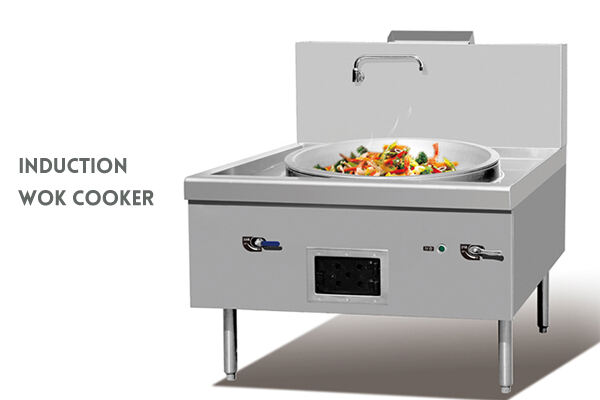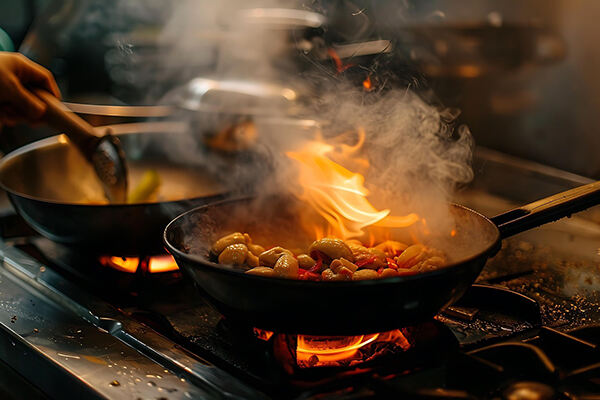သတင်း
ချင်းစားသော အရည်အချင်းဖန်တီးမှုတွင် တရုတ်ပုံစံ အစားအစာဖန်တီးရေးကူပြည်၏ အလုပ်အဆောင်
ကမ္ဘာလုံးရှိ စားသောက်သူများအားလုံးဟာ အရှေ့အားလုံး၏ အစားအသောက်အရသာကို ပို၍လိုလာသည့်အခါတွင်၊ တရုတ် အစားအစာ ပြုစုရန် ဆောက်လုပ်မှု ကုမ္ပဏီဖုန်းအသောက်ပြုလုပ်ရေးဆိုင်များတွင် အဓိကအခန်းကဏ္ဍအဖြစ် အလုပ်လုပ်နေသည်။ " ဝေါက်ဟိုင် " အနုပညာကို အကောင်အထည်ဖော်ခြင်းမှ မြင့်မားသော လုပ်ငန်းများကို လျင်မြန်စွာ လုပ်ဆောင်ခြင်းအထိ၊ ဒီဇိုင်းအတိုင်းထားထား ပစ္စည်းများ ဥပမာ Wok Stations နှင့် ဆားကောင်းစက်ခန်းများကို အသုံးပြု၍ ကုမ္ပဏီဖုန်းအသောက်ပြုလုပ်ရေးဆိုင်များသည် ပြင်ပလာသော လိုအပ်ချက်များကို ကိုင်တွယ်ပြီး အားလုံးကို ထိုးထားသော အဖြေများကို ပေးဆောင်နိုင်သည်။
တရုတ်အစားအစာဖန်တီးမှုဆိုင်ရာ ပစ္စည်းများ ဘာလဲ?

အများသူကြား လုပ်ငန်းရေးပစ္စည်းများနှင့် မတူဘဲ၊ တရုတ်အစားအစာဖန်တီးမှုဆိုင်ရာ ပစ္စည်းများသည် ရောများခံခြင်း၊ ကြွက်ခြင်းနှင့် အမြင့်အိမ်းအပိုင်း အပိုင်းပိုင်းဖန်တီးခြင်းဆိုင်ရာ နည်းပညာများအတွက် ဒီဇိုင်းထုတ်ထားသည်။ ဒီဇိုင်းမှာ သုံးခုခုံ အဓိက အချက်များကို အရှေ့ပြောင်းထားသည်:
- အိမ်းအပိုင်း ကိုင်တွယ်မှု: ပုံမှန်အားဖြင့် တရုတ် ရိုးရောင် စီးကိုင် အသားပေါက်မှုရှိသော လေ့လာမှုများကို ပေးဆောင်နိုင်သည့် 15%စားချရေးတွင် အမြန်ဖြင့် ပထမဆုံးကို ဖြေဆိုးရန် အထူးသဘောဖြင့် ပိုမို အားကြီးပေးသည့် BTU ထွက်ကုန်များထက်
- ဝสด်ပစ္စည်း၏ အရှုံးအသား: Heavy-duty carbon steel woks and stainless steel ဝါးဆိုင်မှုများ နေ့စဉ်အသုံးပြုမှုကို မျှော်လင့်ခြင်းနှင့် အိမ်အိုင်အားကို ကိုက်ညီစွာ ထိန်းသိမ်းနိုင်သည်။
- လုပ်ငန်းစဉ်တောင်းဆက်မှု: မော်ဂျူးလာ ဝေါက်စီးအခန်း ချောက်ချားများ၊ လေထွက်မှု၊ နှင့် ပြင်ဆင်ရန်ဒေသများကို ပေါင်းစပ်၍ ရောင်းရှုပ်ထွေးသော ကိုက်ချိန်များတွင် လှုပ်ရှားမှုကို နည်းသောကြောင်းဖြစ်စေသည်။
အဓိကကဏ္ဍများ ပါဝင်သည်:
- ဝေါက်စနစ်များ: ဂိတ် သို့မဟုတ် induction ဖြင့်အင်ပေးထားသော စျေးဝင်းများကို နှံချင်းရန် ကိုင်တွယ်မှုအတွက် ထောင့်မှန်လှည့်ပတ်သော ဆိုင်းများဖြင့် တည်ထောင်ထားသော အဆိုပါ စျေးဝင်းများ။
- လုပ်ဆောင်ရာများသည်: စက်မှုထဲတွင် ထုတ်လုပ်ထားသော ဆိုင်းပြီး ထိုးထားသော အပ်ပလိုင်စ်များ၊ ဥပမာ ဆားကို အပူပြောင်းစေရန် နှင့် ရေကြွကို အပူပြောင်းစေရန် အတူတူ ဆောင်ရွက်များကို ချက်ချင်း ချိုးဖောက်ထားသော ဆားကို အပူပြောင်းစေရန် အပ်ပလိုင်စ်များ။
- အပူကို ထိန်းသိမ်းသော အပ်ပလိုင်စ်များ: နားထောင်မှုအတွင်း အပူပြောင်းစေရန် နှစ်စဉ်အတွင်း အပူပြောင်းစေရန် အပူကို ထိန်းသိမ်းထားသော အဆင့်မြင့်သော အပူထိန်းသိမ်းခြင်းအတွက် ကိရိယာများ။
အကောင်းဆုံး တရုတ် အစားအစာ ပြုလုပ်ရေး ကုမ္ပဏီများ အခြားသော အထူးဆိုင်ရာ နည်းလမ်းများထက် အမြန်နှင့် ကိုက်ညီမှုဖြင့် ပိုကောင်းမွေ့သော အပ်ပိတ်များ ဖန်တီးရန် ဒီ အ素ိမ်းများကို အကြံပြုသည်။
တရုတ် အစားအစာ ပြုလုပ်ရေး အပ်ပိတ်များကို ဘယ်အကြောင်းရွေးချယ်သင့်လဲ?

တရုတ် ကိရိယာများသည် လွယ်ကူသော အလုပ်များနှင့် တိကျမှုတွင် ဥရောပနိုင်ငံများ၏ အများစုထက် ကောင်းမွေ့သည်။ ဥပမာ:
- ဝေါက်ဟိုင် အမှန်တက်မှု: ဂိုင်အင်ပowered တရုတ် range stoves နှင့် induction wok cookers stir-fries ကိုဖန်တီးရန်လိုအပ်သည့်မြင်းချောင်အိုးအား ဝေါက်ဟိုင် (wok ၏ “breath”) ဖြစ်စေ၊ ဆွဲမှုရှိ smoke ရasa ကို。
- စွမ်းအင် ထိရောက်မှု: Induction wok cookers ရှိ induction technology သည် တိုင်းတူသော temperature control ကိုထိန်းသိမ်းထားရေးနှင့် fuel ကျသတ်ချက်များကိုလျော့နည်းသည်။
- တည်ငြိမ်မှု: အများကိုင်သုံးစွဲမှုကို ရောက်ခံရန် တည်ဆောက်ထားသည့် ပစ္စည်းများ၊ ဥပမာ hot holding cabinets နှင့် steamers ဖြင့်လည်း ကိုင်ဆက်ထားသော commercial rice cookers များ မြင့်မားသော ရောင်းဝယ်အရေအတွက်ရှိ ကိုက်ချီမှုများအတွက် ပိုင်ဆိုင်သည်။
လုပ်ဆောင်မှုနှင့် ကိုယ်စားလှယ်များကို အဆင့်တက်မှုအဖြစ် ပြုလုပ်ခြင်းဖြင့်၊ တရုတ်အစားအစာဖန်တီးရေးပစ္စည်းထုတ်လုပ်သူများမှ အရသာနှင့် ထုတ်လုပ်မှုနှစ်ခုစလုံးကို ပိုမိုလှုပ်ရှားစေသော အဆောက်အအုံများကို ပေးဆောင်ပါသည်။
ကိုက်ချီမှုအဆောက်အအုံများတွင် အဓိက တရုတ်အစားအစာဖန်တီးရေးပစ္စည်းများ
- Wok နှင့် Wok Station: ကာဘန်နှင့် wok station တစ်ခုဖြင့် တစ်စုံတစ်ယောက်တည်းဖြင့် ပိုမိုများစွာ ပူပြီး ညီညွတ်စွာ အစားအစာကို လုပ်ဆောင်နိုင်သည်။ အမြင့်ပူပြင်းထန်မှုနှင့် ပိုမိုများစွာ လှုပ်ရှားနိုင်သော အစားအစာများအတွက် ပိုင်ဆိုင်သည်။
- တရုတ် ရိုးရောင် စီးကိုင် :အဲဒီကိုက်တွေမှာ ပါဝင်နေသော အားကြီးဆုံး ချိုးဖောင်းတွေ (ဥပမာ- တရုတ်ပြည်ထောင်စု၏ wok ချိုးဖောင်းဟာ မြန်မာပုံစံ လေ့လာရန် မဟုတ်ဘဲ အားလုံး gas မှာ မလူကြီးမှားမှုမရှိသော အမျိုးအစားဖြစ်သည်) ကို တောင်းပန်ခြင်း၊ ရေချခြင်းနှင့် အားထိုးခြင်းကို တစ်ခါတွင် လုပ်ဆောင်နိုင်စေရန် ဖြစ်သည်။
- ကုမ္ပဏီ Rice Cooker နှင့် Warmer: အားထိုးစက်နှင့် တူညီသော အားထိုးစက်သည် အိမ်မှာ အလုပ်လုပ်နေသောအခါ အဆိုပါ အသားများကို နာရီများစွာ ထိုးထားသောအခါ ဖြောင့်မှုကို ထိန်းသိမ်းပေးသည်။
- Induction Wok Cooker: ယင်းသည် ပုံစံအသစ်များနှင့် ပုံစံအဟောင်းများကို တွေ့ရှိခြင်းဖြင့် ပိုမိုများသော ပူခြင်းနှင့် လုပ်ဆောင်ချက်များကို ပေးသည်။
တရုတ်အစားအသောက်ပြုလုပ်ရေးဆိုင်ရာ မှူးကိရိယာများ၏ အကောင်အထည်ဖော်မှုများအပေါ် သက်ရောက်မှု
တရုတ်အစားအသောက်ပြုလုပ်ရေးဆိုင်ရာ မှူးကိရိယာများကို ပေါင်းစဉ်းခြင်းသည် သုံးခုမြောက် တွင် တိုင်းတာနိုင်သော ပုံစံဖြင့် ကိုက်နှိပ်ခြင်းဖြင့် အစားအသောက်ပြုလုပ်ရေးဆိုင်ရာ ဒိန်မှုများကို ပြောင်းလဲသည်:
-
အလုပ်သမားများ၏ အကောင်အထည်ဖော်မှု
- တရုတ် Range Stove တစ်ခုသည် 2-3ဆိုင်ရာမှူးကိရိယာများကို အစားထိုးပြီး အမြင့်ဆုံးအချိန်များအတွင်း အလုပ်သမားများ၏ လှုပ်ရှားမှုကို လျော့ချသည်။
- ကြောပ်စီးသော အင်္ဂါများနှင့် ဆေမာ့တာဖြင့် ကြောပ်စီးမှု လုပ်ဆောင်ချက်များ အလုပ်လုပ်ရန် အလွယ်တကူ ဖြစ်သည် 90%ကြောပ်စီးမှု၏ အဆင့်အတန်းများကို လုပ်ဆောင်ခြင်းဖြင့် အထူးသော အလုပ်များအတွက် အရိုးရိုးများကို လွတ်လပ်စေသည်
-
အကြီးအကျယ်တွင် ကိုက်ညီမှု
- ပြောင်းလဲနိုင်သော သိပ္ပံပုံစံတွင် အပူချိန်ထိန်ချက်များ အသုံးပြု၍ အစားအစာများ၏ အပူချိန်ကို ထိန်ချိန်ထားခြင်းဖြင့် 0.6℃ပစ္စည်းရောင်းချသည့် အမှန်တကယ်ရှိသော အပူချိန်များ၊ အဆုံးသတ်မှုကို လျော့နည်းစေသည်။
- အတွင်းရောင်းထုတ်လုပ်ခြင်းဖြင့် ဆေးကြေးစနစ်များဖြင့် ဝေါက်စီးအဆောက်အအုံများသည် လေအရည်အချင်းရှိစေရန် အလုပ်အချိန်ကို အရှည်ပိုများစေပြီး အလုပ်သမားများအတွက် အလုပ်အတွက် အလုပ်သာမျှ ဖြစ်စေသည်။
-
မီးနှုန်းဖြန့်ချိမှု
- အင်ဒักশနယ် ဝေါက်စီးကုန်ကျေးဇူးများဖြင့် အင်ဒักရှင်များဖြင့် 'ပြင်ပြသမှု' အစားအစာတွင် ဆက်လက်သုံးသည့် အတွက် အကြောင်းအရာများကို ဖြန့်ချိပေးသည်။
- အမြင့်ပူပြင်ထွက် (အများဆုံး) 150,000 BTU ) တရုတ်ပြည်ထောင်စု၏ wok burners မှ အလွန်ကျသော wok hei အစားအစာများကို အရှေ့ပိုင်းခုန်များတွင် ဖန်တီးရန်မဖြစ်နိုင်သော အရာများကို ရှေ့ဆောင်ပေးသည်။
အလုပ်လုပ်သူများအတွက် ဒါဟာ ပြောင်းလဲသွားပါတယ် 18-22%လျှော့ချထားသော ဘီလီတ်များနှင့် 30%အာရှလိုင်းရစတာန်များတွင် ပြင်ဆင်ထားသည့် ဇယားကောင်ပြောင်းလဲမှုကို အလိုက်အလျောက် ၂၀၂၃ ခုနှစ် NRA ဒေတာ .
အဆုံးသတ်
အခြားမျိုးသီးသီးတစ်ခုနှင့် ကုန်သုံးမှုကို ပေါင်းစပ်လိုက်သည့် ဆယ်စုနှောင်းခေတ် အရိုးကူးများသည် တရုတ်အစားအစာ ရွေးချယ်ထားသော ကုန်ပစ္စည်းများ၏ စီးပွားသော အသုံးပြုမှုဖြင့် အဆင်မပြေနိုင်သော အလုပ်တစ်ခုဖြစ်သည်။ တရုတ်အစားအစာ ရွေးချယ်ထားသော ကုန်ပစ္စည်းများကို ရွေးချယ်ခြင်း , ဝေါက်စီးစခန်းများမှ ချီးမှားများကို ပြန်လည်ဖြည့်စွက်နိုင်စေရန် ချီးမှားများကို ပြောင်းလဲနိုင်စေရန် မှားများကို ရွေးချယ်ထားသော ကုန်ပစ္စည်းများကို ရွေးချယ်ခြင်းဖြင့် များသော အရသာများကို သင့် menu တွင် ပိုမိုရှိနိုင်သည်။ ဒါကြောင့် ဘယ်လိုလဲ။ အခုတရုတ် full gas burner ကို စမ်းကြည့်ရအောင်။
အမေးအဖြေများ
Q: "wok" ဆိုသည်မှာ ဘာလဲ?
A: "wok" ဆိုသည်မှာ လုံးဝ အောက်ပိုင်းရှိ တရုတ်လို အစားအစာ ပို့ချခြင်းအတွက် အဓိပ္ပါယ်ဖြင့် အရေးကြီးသော ပန်းချီပြီး ဖြစ်သည်။ ဒါဟာ တရုတ်အစားအစာမှာ အရေးကြီးပြီး stir-frying၊ deep-frying နှင့် steaming တွင် ကောင်းမွန်သည်။ ဒီဇိုင်းကို အိမ်မှာ အပြင်ဆင်မှုနှင့် အလုပ်လိုက်မှုကို ပိုမိုလုပ်ပေးသည်။
မေး- ဝေါ့ခ်နဲ့ ချက်ပြုတ်ဖို့ အကြံပေးချက်တွေက ဘာတွေလဲ။
A: ဆီမထည့်ခင် ဝေါက်ကို အပူပေးပါ။ အသားအရေကို အသားအရေနဲ့ ရောစပ်ပေးပါ။ ချက်ပြုတ်ဖို့ အစိတ်အပိုင်းတွေကို ဆက်တိုက် ပစ်လိုက်ပါ။ သုံးပြီးတဲ့အခါမှာ အမြဲတမ်း သန့်ရှင်းအောင် ပြုပြင်ပေးပါ။
မေး- "wok hei" ဆိုတာ ဘာကိုဆိုလိုတာလဲ။
A: "wok hei" ဆိုတာက အပူပြင်းတဲ့ wok ထဲမှာ ချက်ပြုတ်တဲ့အခါ အစားအစာကို ပေးတဲ့ ထူးခြားတဲ့ မီးခိုးထွက်တဲ့ အရသာနဲ့ အနံ့ကို ရည်ညွှန်းတာပါ။ ဒါက ကျွမ်းကျင်စွာ ပြင်ဆင်ထားတဲ့ တရုတ်အစားအစာရဲ့ လက္ခဏာပါ။
မေး- စားသောက်ဆိုင်တွေက တရုတ် အစားအစာကို ဘယ်လိုများ မြန်မြန် ချက်ကြတာလဲ။
အ: ရက်စတာန်များ၏ ခေါက်ဆွဲသို့မဟုတ် ပိုင်းခြံများသည် အလွယ်တကူ အလုပ်လုပ်နိုင်သည်။ ထို့အပြင် အားလုံးကို အရှုံးဖြင့် ပြင်ဆင်ထားသည်။ ချီဖများသည် အမြန်နှင့် ကျွမ်းကျင်စွာ အလုပ်လုပ်နိုင်ရန် အစီရင်ခံထားသည်။
မေး: တရုတ်ရက်စတာများတွင် ဘယ်မျိုးသော ခေါက်ဆွဲကို သုံးသလဲ?
အ: ဒီတော့ အချက်အလက်ပါ။ တရုတ်ရက်စတာများတွင် အမြန်မြင့်သော ဂိုးခေါက်ဆွဲများ သို့မဟုတ် ဝေါက်ချင်းအတွက် အထူးပြုထားသော ခေါက်ဆွဲများကို သုံးလေ့ရှိသည်။ အချို့သည် အပူချိန်ကိုကြိုက်ညီစေရန် အင်ဒักရှင်ခေါက်ဆွဲများကိုလည်း သုံးနိုင်သည်။
 After-Sales:
After-Sales:
 EN
EN
 AR
AR
 HR
HR
 NL
NL
 FI
FI
 FR
FR
 DE
DE
 EL
EL
 HI
HI
 IT
IT
 PT
PT
 RO
RO
 RU
RU
 ES
ES
 TL
TL
 ID
ID
 SL
SL
 VI
VI
 ET
ET
 MT
MT
 TH
TH
 FA
FA
 AF
AF
 MS
MS
 IS
IS
 MK
MK
 HY
HY
 AZ
AZ
 KA
KA
 UR
UR
 BN
BN
 BS
BS
 KM
KM
 LO
LO
 LA
LA
 MN
MN
 NE
NE
 MY
MY
 UZ
UZ
 KU
KU









